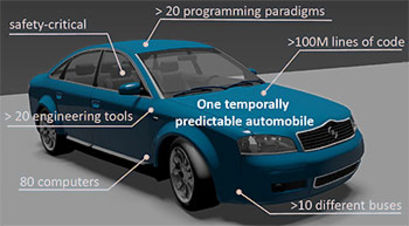Modern vehicles are becoming increasingly complex, with the result that searching for defects is becoming ever more time-consuming. Defects in safety-critical functions in particular must be repaired as quickly as possible. Tried-and-tested procedures do exist to verify that critical functions are free from defects, but these are limited solely to emission checks. However, time response is just as important for safety-critical functions. It is not sufficient, for example, to check whether a brake achieves the correct brake force; this also has to happen within a specified time. The AUTOSAFE project, which was concluded in December 2015 after a duration of three-and-a-half years, has developed techniques with which the procedures for verifying the functional and chronological accuracy of vehicle software can be combined.
German-Indian partnership
The German-Indian cooperation on the AUTOSAFE project resulted from the fact that vehicles are becoming increasingly “software-intensive”, i.e. a large number of new functions such as driver assistance systems are being integrated into them. Germany’s automobile competence is among the world’s most outstanding; India is one of the world’s leaders in the field of software development. This German-Indian partnership consequently combines both the competences and also the challenges faced by German and Indian companies. The German institutes involved in the project were the Technische Universität München, the Institute for Real-Time Computer Systems and INCHRON GmbH; the Indian organisations were IIT Kharagpur, Computer Science and the Tata Research Development and Design Centre (TRDDC).
Outstanding results and successes
The project work focused on the integrated functional and chronological verification of automobile control software such as that which controls braking and speed. The work carried out for this project yielded results on two different levels. Firstly, theoretical challenges were addressed in order to facilitate the functional and chronological verification of software systems to a realistic extent. Secondly, industrial tools were integrated in order to develop a working environment demonstrating that the solutions proposed are expedient in practical terms.
A feasibility study was the result; more work will be necessary to prepare a technically fully developed working environment for the automotive industry. The results could be used by both automobile manufacturers and parts suppliers (such as BOSCH). They will also benefit vehicle software developers (such as Indian industrial partner TRDDC) and developers of software design tools (such as German industrial partner INCHRON).
The prototype of the working environment will be finished at around the time the project ends.
The work produced more than 20 contributions to reputable journals and conferences.
Hans Westphal
DLR Project Management Agency
European and International Cooperation
Tel.: +49 228 3821 -1473
hans.westphal@dlr.de
Prof. Samarjit Chakraborty
Technische Universität München
Chair of Real-Time Computer Systems
Tel.: +49 89 289 -23550
samarjit@tum.de








